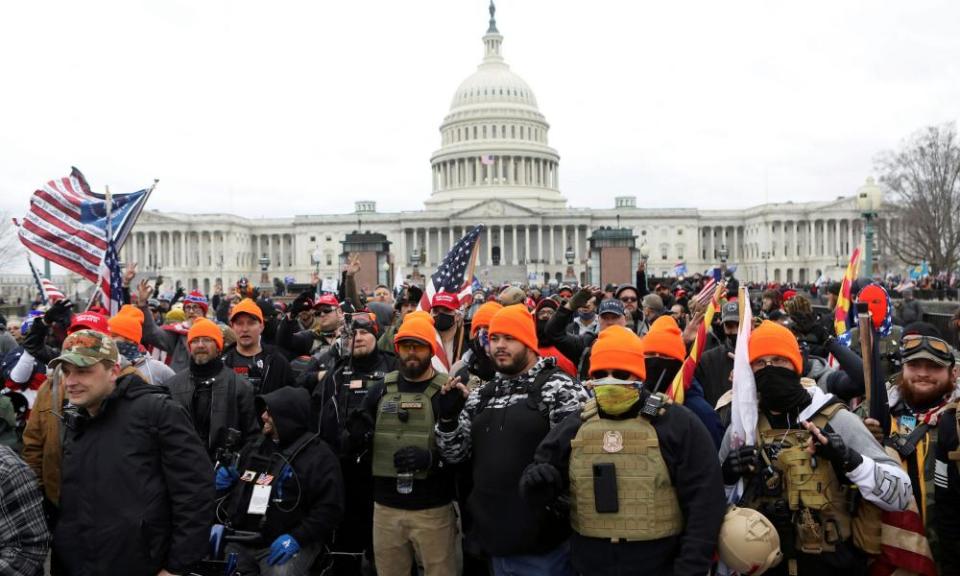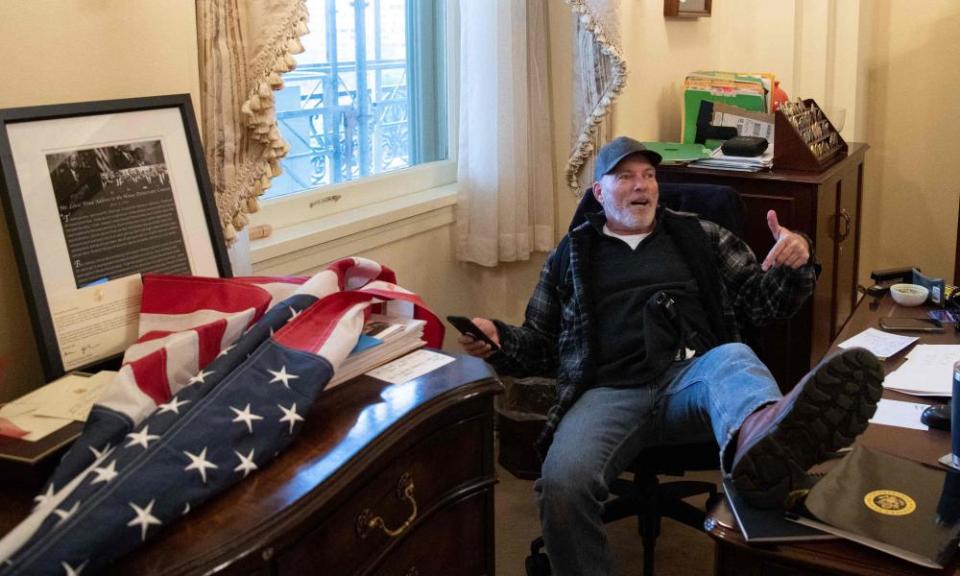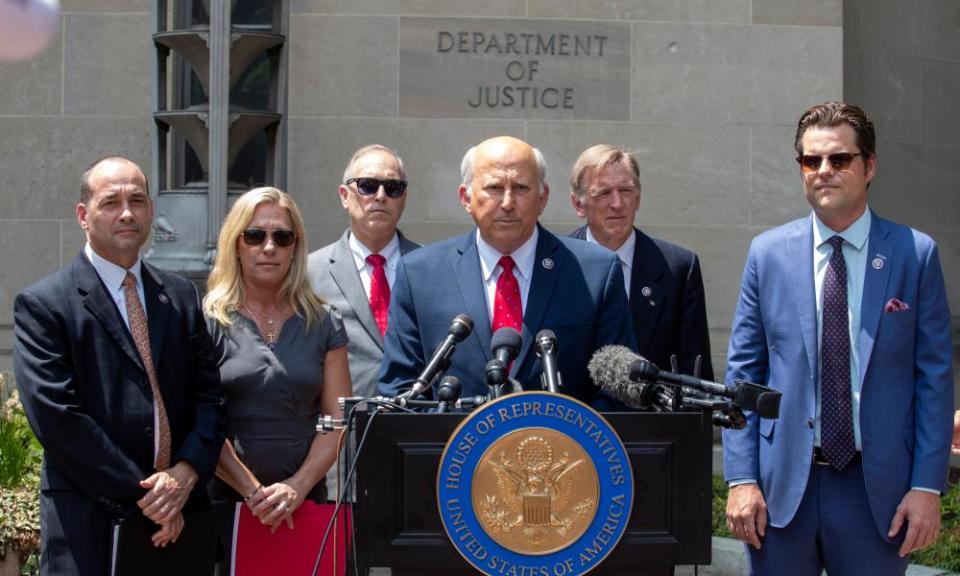Inside the FBI’s Capitol riot investigation: will the attackers be held accountable?
- Oops!Something went wrong.Please try again later.
It’s been one year since a mob of Donald Trump supporters stormed the United States Capitol, as the “stop the steal” rally demanding to overturn the results of the 2020 presidential election turned into a deadly insurrection.
After the attack, the Department of Justice and Federal Bureau of Investigation mobilized one of the largest criminal investigations in American history. Those efforts have so far resulted in more than 700 federal cases and counting, with more suspects expected to be charged. But for all that we have learned about the insurrection and the people who took part in it, crucial questions remain about the fallout of the attack for the far right and what it means to hold its perpetrators accountable.
Federal prosecutors want the arrests and convictions of those responsible to act as a deterrent against extremism and future attempts to undermine democracy, experts say, but despite more than 150 guilty pleas so far, the legacy of 6 January is already contentious. A judicial debate has emerged over the appropriate sentencing for rioters, while trials in the coming months will test whether prosecutors can secure convictions on more serious charges facing far-right extremists.
The fundamental understanding of what happened on 6 January is also being increasingly contested, as Republican lawmakers and rightwing media attempt to whitewash the events and reframe the insurrection as an act of justified political protest. More than any court case, researchers say, this revisionist narrative may have long-lasting implications for the far right and for political violence in America.
The suspects
In the months after the insurrection, law enforcement officials investigated hours upon hours of videos from the day, thousands of social media profiles and hundreds of thousands of tips from the public. They have arrested hundreds, sometimes raiding homes where suspects had stockpiled weapons and ammunition.
As the arrests rolled in, researchers began to get a more complete picture of who was involved in the attack. The people charged came to Washington DC from nearly every state in the union, and ranged from teenagers to senior citizens. Beyond sharing a fervent support for Trump and belief in election conspiracies, no single profile has emerged.
Overall the suspects are overwhelmingly male – about 80% according to research from George Washington University’s project on extremism – and the average age is 39. The vast majority of suspects are white. Many belonged to far-right militias and white nationalist groups that played an outsize role in the attack, but most had no direct affiliations with extremist organizations.
“They’re sort of your nextdoor neighbor,” said Kurt Braddock, an assistant professor of communication at American University and extremism researcher. “It shows how far far-right ideologies have extended.”
There were white-collar workers, people who came with their family members and a cross-section of other Trump supporters radicalized into committing political violence. Many believed in the QAnon conspiracy movement that viewed Trump as a messianic figure who would return to office and destroy a cabal of liberal elite pedophiles.
The charges and sentencing
Although the charges range from misdemeanors such as trespassing to violent assaults against Capitol police officers, the bulk of cases that have come in front of a judge so far have involved individuals pleading guilty to minor charges. Except for some high-profile rioters – including “QAnon shaman” Jacob Chansley, who was sentenced to 41 months in prison after pleading guilty to a felony charge of obstructing Congress – most of the sentences doled out have not exceeded several weeks in prison. Many of the rioters have received no jail time at all, instead receiving fines or probation.
There have been significant differences between how US district court judges have approached sentencing and cases. One group of judges has questioned why prosecutors are seeking jail time for misdemeanor offences such as trespassing on Capitol grounds. US District Judge Trevor McFadden, a Trump appointee, made comparisons between Black Lives Matter protesters and the 6 January attackers and told a defendant that he was “acting like all those looters and rioters last year”.(McFadden did, however, later reject a defendant’s claim that he was being treated unfairly compared with leftist protesters in Portland.)
Other judges have vehemently rejected the comparison to BLM, and have insisted that participants in the riot face serious consequences for their involvement. US District Judge Tanya Chutkan stated that the siege was an unprecedented attempt to “violently overthrow the government” and “stop the peaceful transition of power”. Chief US District Judge Beryl Howell questioned why prosecutors were letting rioters accept lighter misdemeanor plea deals and lamented that “the government has essentially tied the sentencing judge’s hands”.
“No wonder parts of this public are confused about whether what happened on 6 January at the Capitol was simply a petty offense of trespassing, with some disorderliness, or was shocking criminal conduct that posed a grave threat to our democratic norms,” Howell said.
The more complex cases and serious charges will probably go to trial in the coming months, researchers say, including those involving members of the Proud Boys, Oath Keepers, Three Percenters and other far-right militias.
One member of the Oath Keepers, Jason Dolan, already admitted as part of a plea deal that he traveled with other militia members and stashed an M4 rifle at a Comfort Inn a short drive outside the Capitol. In December, 34-year-old Matthew Greene became the first member of the Proud Boys to plead guilty in a felony conspiracy case, with prosecutors stating that he and other Proud Boys coordinated their actions using programmable radios and dressed to conceal their affiliation with the group. After the riot, Greene allegedly ordered more than 2,000 rounds of assault-rifle ammunition, bragged that his group “took the Capitol” and told a friend to study guerrilla warfare and be ready to “do uncomfortable things”.

The criminal trials this spring for felony charges such as obstructing Congress and a multi-defendant conspiracy case against members of the Oath Keepers may reveal new details about the level of coordination and planning that went into the attack on the Capitol. But they will probably also present difficulties for prosecutors. The government has already succeeded in dismissing some pre-trial defense objections, such as whether the common charge of “corruptly obstructing an official proceeding” was unconstitutionally vague, but more challenges will come.
“It’s going to get complicated very quickly,” said Seamus Hughes, deputy director of the program on extremism at George Washington University. “You’re going to get into uncharted water with this prosecution at some point, just by the sheer number.”
The investigation
The FBI received more than 250,000 tips related to the siege, including family members turning in relatives and Facebook friends reporting old high school acquaintances. One suspect, New York state’s Robert Chapman, told a match on the dating app Bumble that he had stormed the Capitol and bragged about making it all the way to the National Statuary Hall. “We are not a match,” the other Bumble user replied, according to court filings, before sending a screenshot of their exchange to law enforcement.
More than 80% of cases cite some form of social media as evidence for the charges, but the FBI’s investigation goes far beyond relying on amateur online sleuths and combing through social media profiles. Law enforcement has also used invasive technology and surveillance tactics that could expand law enforcement powers and have implications for future investigations.
In addition to using facial recognition software to identify rioters, itself a deeply controversial practice, law enforcement appears to have expanded its use of geofencing search warrants – a process that involves using data from digital services to locate people within a certain area during a given time period. In practice, it means that authorities can demand Google hand over anonymized user location data, then ask for specific users’ private information, including their names, emails and phone numbers. Dozens of Capitol rioter cases cite Google location data in their court filings, according to a Wired investigation.
“It’s going to set a precedent for geofencing,” Hughes said. “If they can get enough successful prosecutions … that will be something that’s used in future investigations.”
The FBI’s use of surveillance has come under additional scrutiny in recent weeks after a New York Times investigation found that the bureau deployed surveillance teams to monitor Portland activists’ protests against policing, a move that civil rights groups condemned as domestic spying.
Whitewashing the attack
As the FBI has carried out its investigation, there has been a parallel effort to create a different narrative of the insurrection. Republican politicians and conservative media have been on a months-long campaign to whitewash the attack on the Capitol. Over the past year they have settled on a story that presents 6 January as a largely peaceful protest for legitimate election grievances, sometimes baselessly claiming that any violence was the result of antifa or leftist infiltrators.
Prime-time Fox News host Tucker Carlson in November aired a three episode special entitled Patriot Purge that uncritically interviewed rightwing activists with ties to the white nationalist movement, who claim that the FBI investigation is an unjust political crackdown on conservatives. Carlson states in it that there is a leftist “purge aimed at legacy Americans” and features sympathetic interviews with people who took part in the insurrection. Two Fox News contributors quit over the special, with one suggesting that it would lead to violence.
Many of the rioters have embraced a burgeoning celebrity status within the far right. Some suspects refer to themselves as “1/6ers”, and have launched online fundraising campaigns where they identify as political protesters and victims of government persecution. One collective fundraising page for the approximately 40 suspects being held in pre-trial detention has already raised hundreds of thousands of dollars and sells hoodies emblazoned with the slogan “free the 1/6ers.”
Other high-profile suspects have created individual pages to capitalize on their notoriety. Richard “Bigo” Barnett, a self-described white nationalist who stole a document from speaker of the house Nancy Pelosi’s office and was photographed putting his boots up on her desk, launched a fundraising site that doubles as a manifesto for his anti-government views.

“Richard Barnett’s picture at Speaker Pelosi’s desk has become the face of the new anti-federalist movement,” Barnett’s website states on its fundraising page. “We will not go gently into that good night. Click below to donate to the fight.”
The group being held in pre-trial detention at the Correctional Treatment facility in Washington DC has also banded together while incarcerated, calling themselves the “Patriot Wing” and attempting to become far-right influencers. These suspects include numerous members of extremist groups such as the Proud Boys and Oath Keepers, as well as others facing more serious charges of violence and conspiracy related to the insurrection. They have started writing open letters and reportedly passed around a handwritten newsletter in the jail, in which they boast about reciting the pledge of allegiance and singing the national anthem together.
Some Republican lawmakers have amplified this far-right narrative that the suspects being held in pre-trial detention are political prisoners and unjustly suffering for their beliefs. Representatives including Marjorie Taylor Greene, Paul Gosar, Matt Gaetz and Louie Gohmert have rallied in support of insurrection suspects and staged an attempt to visit the jail, claiming a conspiracy to mistreat the prisoners and that their detention was evidence of Marxism and totalitarianism. Meanwhile, more mainstream Republican lawmakers have stonewalled a House committee investigation into the roots of the attack, and Trump allies have refused to cooperate with subpoenas.

All these developments – the solidifying of in-group identity among the more dedicated insurrections, the financial support for rioters and Republican lawmakers’ willingness to paint them as martyrs – concerns extremism researchers about the long-term effects of 6 January. Even if those responsible face significant prison sentences, there is little incentive for them to de-radicalize once incarcerated.
“You may get to a point where folks who spend their time in jail come out and are basically provided a kind of a rockstar status within the movement,” Hughes said.
The revisionist history of 6 January has also correlated with a declining interest among Republicans in punishing those involved. After the insurrection there was wide bipartisan support for prosecuting rioters, but a Pew Research Center study in September found the number of Republicans who believe it is important to hold those responsible legally liable for their actions significantly declined over the course of the year. Involvement in the events of 6 January is also apparently not disqualifying for Republicans seeking public office. At least 10 people who attended the Washington rally have now been elected to various positions, according to HuffPost, including three in state legislatures.
What concerns some extremism researchers is that while it’s critical for prosecutors to secure convictions for those involved in the insurrection, these broader problems remain of how deeply embedded the far right has become in American politics. Even if authorities may be better prepared against future rallies aimed at subverting the democratic process, the reaction from rightwing media and some Republican lawmakers has threatened to legitimize far-right ideology and resorting to political violence to achieve their goals.
“January 6 exemplified what the far right is now,” Braddock said. “But it definitely doesn’t end with January 6.”

